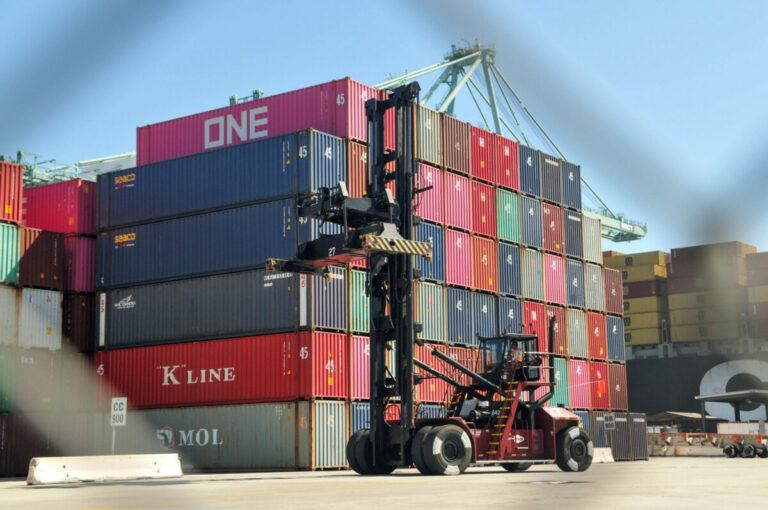
Total container volumes were again divided at the San Pedro Bay Port Complex in August, with the Port of Los Angeles recording notable gains while the Port of Long Beach sagged in comparison.
On the year, both ports remain down on volume totals when compared to last year – in part because of the pandemic-related anomaly in last year’s imports, but also because trade worldwide this year has decreased.
“Overall, as we navigate through what’s expected to be a muted peak season, global trade is slower overall,” said Port of L.A. Executive Director Gene Seroka, citing the typical surge in imports ahead of the winter holidays. “Export numbers out of Asia are declining. China has had three consecutive months of weak exports. South Korea and Vietnam” – who, with China, are the port’s top three import sources – “have also seen drops in their respective volume.”
The Port of L.A. moved a total of 828,016 TEUs – 20-foot equivalent units, the standard measurement of container cargo – in August, representing an increase of 3% from August of last year. This included 433,224 import TEUs (up 7% from the prior year) and 124,988 export TEUs (up 22%). This was the first year-over-year total volume and import increase in 13 months and the fourth straight month of increased export numbers as well. Empty containers were down.
“Coming off a lighter July, August was a very solid month,” Seroka said.
Meanwhile, Long Beach moved a total of 682,312 TEUs in August, including 325.436 import TEUs – both down 15.4% from last year. Exports there were 93,402 TEUs, a decrease of 23.1%. On the year, L.A. has moved around 5.65 million TEUs and Long Beach has moved around 4.99 million TEUs – down 21% and 24.4%, respectively, from the same period last year. Empty containers were also down at Long Beach.
This is not to say that either port is experiencing a serious downturn in business – in fact, Seroka cited preliminary data showing that San Pedro Bay’s market share of ocean-going cargo is up 3.5%. Comparisons to five-year averages are off by single digits only and are most likely skewed by the late-2021, early-2022 period that saw a flotilla of ships anchored on the horizon as a logjam of imports awaited their turn at the ports. Although volumes by month have been slightly sclerotic this year, they largely align with where the ports were before the Covid-19 pandemic affected supply chains and spurred consumer demand.
“We anticipate a modest peak season as our cargo numbers continue to stabilize at pre-pandemic levels,” Port of Long Beach CEO Mario Cordero said in a statement. “Over the long term we are strengthening our competitiveness by investing in digital and physical infrastructure projects that will keep goods moving efficiently for decades to come.”
Several factors are depressing global trade.
As Seroka cited, Asian exports have taken a hit this year. On top of the direct export numbers, another way to illustrate this is demand for empty containers: L.A. and Long Beach sent 518,002 empty TEUs last month; in August of last year they sent 688,206.
Additionally, domestic warehouses remain well stocked. Data shows nationwide that the inventory-to-sales ratio is around 1.4 (meaning there is, on average, 40% more inventory available); Seroka said economists want that ratio closer to 1.1, which translates to a 10% inventory.\
And while the Commerce Department reported that retail sales excluding vehicles and gasoline eked up 0.1% in August and are up 2.1% on the year, people just aren’t shopping the way they did during the pandemic.
“American consumers remain resilient and continue to spend – just not at the historic levels we saw during the pandemic,” Seroka said. “And some of our discretionary income is being spent on experiences and services rather than staying at home and shopping online. All the planes I’ve been on lately have been full.”
Leaders are relatively optimistic for the remainder of the year. Seroka said the numbers indicate a total volume in the range of 700,000 TEUs for L.A., while Long Beach leaders have previously indicated they are proactively courting shippers in light of the logjam at the Panama Canal.
And with a labor contract for longshore and warehouse workers ratified last month, shippers should be comfortable their cargo will be taken care of here for the next six years.
